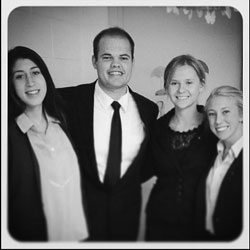Over 60 students, faculty, and members of the University community gathered in Rechnitz Hall’s DiMattio Gallery for the opening reception of works created by faculty of the Art and Design Department on Friday, Jan. 27.
The new exhibit showcased only faculty work and will be up until March 10. Doors opened at 7 p.m., and light refreshments were served in the Rechnitz Hall lobby.
Upon entrance to the exhibit, patrons gathered in the first and second floors of the gallery. The space was covered in pieces composed of different mediums through varying techniques.
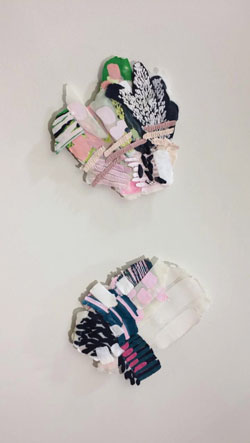
“I think the Faculty Exhibition is a wonderful opportunity for students, the Monmouth University community, and the community at large to gain an insight into the artistic work of the Department of Art and Design faculty,” said Scott Knauer, Director of Galleries and Collections and professor of art and design.
“Of course the faculty interact with students constantly, but this exhibition presents an opportunity for students to ask faculty about their personal work, inspirations, concepts, ideas, influences, as well as discussing a variety of materials used for photography, sculpture, painting, ceramics, interactive media, and animation,” Knauer added.
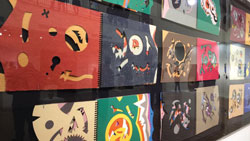 Scattered in the center of the room were a number of cream sculpture stands. On three of the stands were different but related pieces created by Eileen Sackman, an adjunct professor of art and design. Each of the works incorporated rhino sculptures and pots in a series that touched upon animal rights.
Scattered in the center of the room were a number of cream sculpture stands. On three of the stands were different but related pieces created by Eileen Sackman, an adjunct professor of art and design. Each of the works incorporated rhino sculptures and pots in a series that touched upon animal rights.
“The forms I construct are essential for communication. This exploration and the formation of my work opens a venue for change. My current series of work is a study of animal poaching,” said Sackman. “The abuse and exploitation of animals has driven many of the world’s species to near extinction and beyond. It is my hope to open the minds and hearts of the viewers. A movement beyond the frivolous and unjustified desires of poachers and practitioners, and into the needs of the voiceless animals who desperately require a change.”
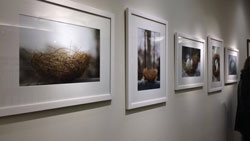 On the right side of the gallery wall was a mixed-media series by Pat Cresson, a professor of art and design. She asserted that the most important element of her work is the design period. She said, “I start with old drawings and old prints and glue them on. Then I coat it with wax, and then I start painting on top of it. Sometimes I cover up most of the collage, and then I start scraping it away. I worked as an archeologist for a while, and it’s like excavating. I dig into the surface, and pull out what I need.”
On the right side of the gallery wall was a mixed-media series by Pat Cresson, a professor of art and design. She asserted that the most important element of her work is the design period. She said, “I start with old drawings and old prints and glue them on. Then I coat it with wax, and then I start painting on top of it. Sometimes I cover up most of the collage, and then I start scraping it away. I worked as an archeologist for a while, and it’s like excavating. I dig into the surface, and pull out what I need.”
 Displayed in the center of the room was a large laser-sketched blimp sculpture by Tom Baker, Chair of the Department of Art and Design. There were multiple other pieces made by Baker through his laser-sketching technique that were placed throughout the exhibit on the first floor.
Displayed in the center of the room was a large laser-sketched blimp sculpture by Tom Baker, Chair of the Department of Art and Design. There were multiple other pieces made by Baker through his laser-sketching technique that were placed throughout the exhibit on the first floor.
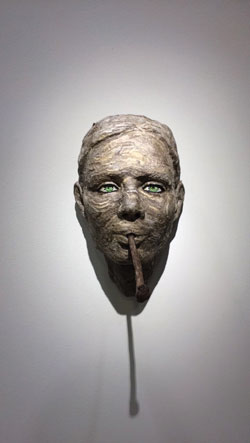 Vincent DiMattio, a professor of art and design, and the namesake of the gallery contributed twelve multi-colored books to the show. On each of the pages he spent time cutting out different shapes using an x-acto knife. When the books were opened, as displayed in the show, the different layers of shapes and colors were visible through the books.
Vincent DiMattio, a professor of art and design, and the namesake of the gallery contributed twelve multi-colored books to the show. On each of the pages he spent time cutting out different shapes using an x-acto knife. When the books were opened, as displayed in the show, the different layers of shapes and colors were visible through the books.
“Back in the seventies paper companies would send you paper sample books in the mail. When I got the books, I would cut the pages differently, and see what happened underneath each of the pages,” said Dimattio. “I didn’t even know I still had the books, until I discovered them recently, and the idea for this piece grew from that. I began working on these ones last summer, and it was a lot of work because it is all hand cut. I had to be very careful with how I used the tools.”
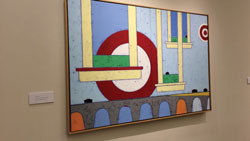 In the near vicinity of DiMattio’s work, a sculpture of a woman’s head with piercing green eyes hung from one of the gallery walls. Her skin resembled bark, and a long rod made of the same material, protruded from her mouth, and curved at the end. Kimberly Callas, a professor of art and design, created the piece, titling it “The Beekeeper’s Wife.” Callas also had another sculpture of a light green male bust form. The only aspect that was not green were the eyes of the figure which were masked with dried leaves.
In the near vicinity of DiMattio’s work, a sculpture of a woman’s head with piercing green eyes hung from one of the gallery walls. Her skin resembled bark, and a long rod made of the same material, protruded from her mouth, and curved at the end. Kimberly Callas, a professor of art and design, created the piece, titling it “The Beekeeper’s Wife.” Callas also had another sculpture of a light green male bust form. The only aspect that was not green were the eyes of the figure which were masked with dried leaves.
Amongst the sculptures and paintings on the first floor was a more interactive piece that combined a vintage voting machine with custom music software by Mike Richison, an assistant professor of art and design. Instead of selecting candidates, “voters” could select a drumbeat on their ballot. In the end the custom software would create a unique rhythm of drumbeats and debate video snippets.
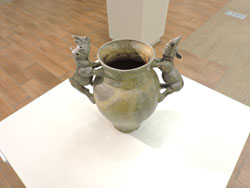 Students like Monica Cioppettini, a senior fine art student, has learned from many of the professors whose works were on display in the show. She said, “It is nice to see their works on the wall. They always tell us how we can improve ourselves, and be better artists. Through their works we can actually see what they mean.”
Students like Monica Cioppettini, a senior fine art student, has learned from many of the professors whose works were on display in the show. She said, “It is nice to see their works on the wall. They always tell us how we can improve ourselves, and be better artists. Through their works we can actually see what they mean.”
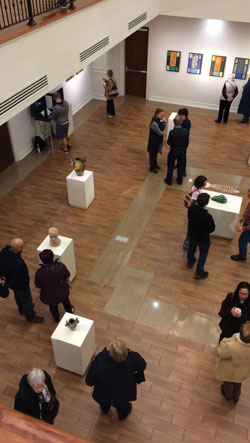 Near the back corner of the room were three large black and white photographs by Andrew Cohen, a professor of art and design. One of the photographs was of the back of a Jewish man praying in front of the Western Wall in Jerusalem. The bricks of the wall took up most of the frame, and the man in dark clothing contrasted starkly with the setting.
Near the back corner of the room were three large black and white photographs by Andrew Cohen, a professor of art and design. One of the photographs was of the back of a Jewish man praying in front of the Western Wall in Jerusalem. The bricks of the wall took up most of the frame, and the man in dark clothing contrasted starkly with the setting.
As patrons ascended to the second floor of the gallery the musical notes of a student playing on a black piano were amplified.
More photography was on display on the second floor of the gallery including a series by Gina Torello, an adjunct professor of art and design. Her photographs were five portraits of a bird nest from different vantage points enclosed in white frames. Some of the photographs of the bird nest included two light tiffany-blue bird eggs.
On the same wall were two large vibrant works by Knauer, made mostly of primary colors. His inspiration derived from areas like the price of gasoline, housing markets, and the production of foods. “One of my pieces is someone on a bicycle. It is a scene at dusk with the bicyclist going towards a deserted downtown area. It is acrylic with vinyl lettering on Styrofoam.”
A number of other faculty members had their works on display as well, and students like Ciopettini benefited greatly. “I am so impressed,” she said. “A lot of the stuff is even different from what they teach, for example all of the works from the print making professors are 3-D. It is really wonderful to see all of the different facets, and skills of our faculty. It is really inspirational.”
IMAGES TAKEN by Jamilah McMillan & Alexandria Afanador


